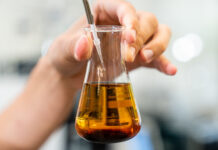 In general, bottled red wines have no problem of protein stability, given that polyphenols and anthocyanins have superficial electronegative charges and interact with proteins derived from grapes. The two classes of grapes’ macromolecules react prematurely from the final stages of fermentation, sometimes precipitating copiously. In poor years, when grapes do not reach proper maturation of cellular tissues, there is a color collapse and the wine takes on a pinkish color typical of rosé wines. Anthocyanins are always removed from the grapes’ proteins; their effect is minimized by the use of Endozym TMO, enzyme preparation that combines pectolitic activity with hemicelluloses activity. AEB Group suggests this enzyme in order to protect the color from 20 to 70%, improving the wines’ color and taste aspects. At the end of alcoholic fermentation polyphenol-protein interactions play an important role only in case of technological interventions such as clarification with gelatin or the use of lysozyme. In both cases, the company proposes Bentogran, which interacts with proteins protecting anthocyanins.
In general, bottled red wines have no problem of protein stability, given that polyphenols and anthocyanins have superficial electronegative charges and interact with proteins derived from grapes. The two classes of grapes’ macromolecules react prematurely from the final stages of fermentation, sometimes precipitating copiously. In poor years, when grapes do not reach proper maturation of cellular tissues, there is a color collapse and the wine takes on a pinkish color typical of rosé wines. Anthocyanins are always removed from the grapes’ proteins; their effect is minimized by the use of Endozym TMO, enzyme preparation that combines pectolitic activity with hemicelluloses activity. AEB Group suggests this enzyme in order to protect the color from 20 to 70%, improving the wines’ color and taste aspects. At the end of alcoholic fermentation polyphenol-protein interactions play an important role only in case of technological interventions such as clarification with gelatin or the use of lysozyme. In both cases, the company proposes Bentogran, which interacts with proteins protecting anthocyanins.



